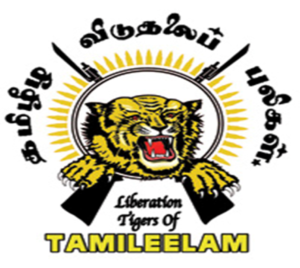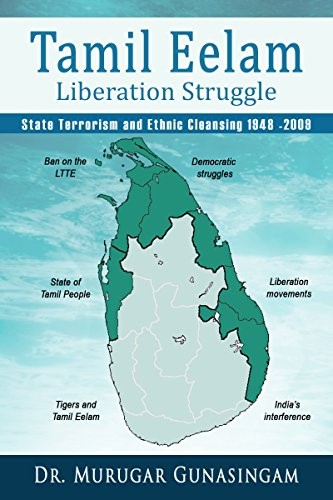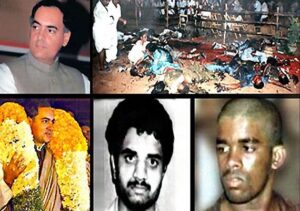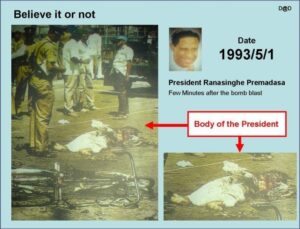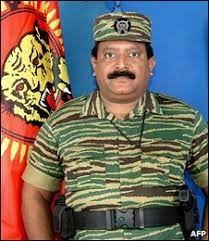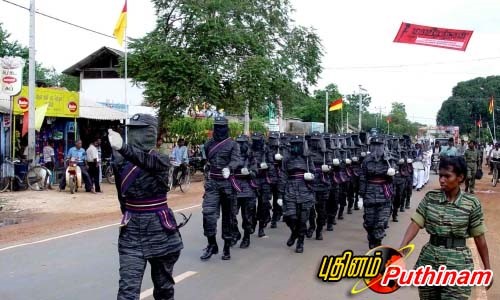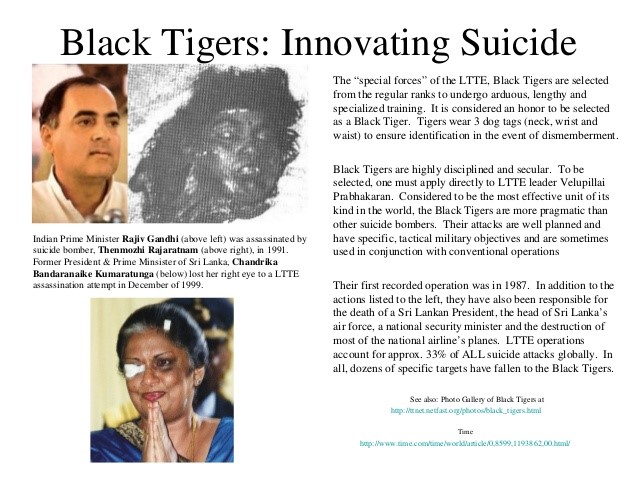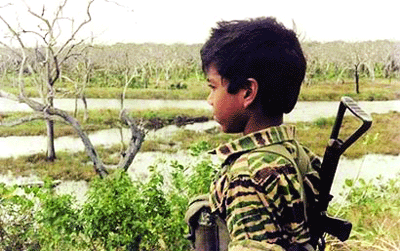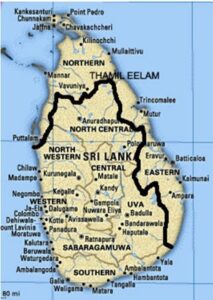LTTE
- Founded and led by Velupillai Prabhakaran, the LTTE is a paramilitary organization that has waged a campaign since the 1970’s with the goal of creating a separate Tamil state in northern Sri Lanka.
- Known as the Tamil Tigers, the LTTE is notorious for introducing suicide bombers in general and female ones in particular.
- They have carried out more suicide attacks than Hamas, al Qaeda and Islamic Jihad combined.
- Members of the LTTE have donned Velupillai Prabhakaran self-styled President and uniforms to directly battle the Lankan military – on land, sea and in the air.
1948
- Sri Lanka, then known as Ceylon, gains independence from British rule. Ethnic Tamils feel disenfranchised by the so-called “Citizenship Act” which denied citizenship to the Tamils and their descendents brought from India by the British to work on tea plantations
1956
- Solomon Bandaranyake, then prime minister, enacts a law making Sinhala the only official language of Sri Lanka, alienating the Tamils. Peaceful protests by Tamils are broken up by a Sinhala mob and riots follow.
1957/65
- Pacts are signed between the government and the Tamils giving them a measure of regional autonomy and freedoms in language and education, but the agreements remain largely on paper.
1970
- New constitution enshrines earlier law making Sinhala Sri Lanka’s official language and makes Buddhism the country’s official religion, further alienating Tamils who are mainly Hindus and Christians.
1972
- Ceylon becomes a Republic and is officially renamed the Republic of Sri Lanka. Velupillai Prabhakaran forms the Tamil New Tigers group to set up a separate homeland- the Tamil Eelam.
1975
- Tamil New Tigers re-named Liberation Tigers of Tamil Eelam (LTTE)
1978
- LTTE proscribed as an illegal organisation.
1981
- Riots in Jafna. A state of emergency is declared.
1983
- First guerrilla-style ambush by LTTE kills 13 soldiers. During “Black July”, Rioting erupts killing hundreds of people. About 150,000 Tamil refugees flee to India, where Tamil military training camps are established.
1987
- The Indian government cracks down on armed Tamil groups in India. First suicide attack by LTTE kills 40. Indo-Sri Lanka Peace Accord signed and India agrees to deploy peace keepers – the Indian Peace Keeping Force (IPKF), which quickly gets drawn in to the civil war.
1990
- IPKF withdraws from Sri Lanka. LTTE becomes the prominent Tamil armed group.
1991
- Rajiv Gandhi, then Indian prime minister, is assassinated by a female LTTE suicide bomber.
1993
- Ranasinghe Premadasa, then president of Sri Lanka, is killed in a LTTE suicide bomb attack.
1999
- Chandrika Kumaratunge, a former prime minister and later the first female president of Sri Lanka, is wounded in an assassination attempt during an election rally.
2002
- Norway-brokered ceasefire between the LTTE and the Sri Lankan government comes into effect. It holds for five years despite many incursions from both sides. A road linking Jaffna peninsula and the rest of Sri Lanka opens after 12 years.
2004
- The LTTE splits. Vinayagamoorthi Muralitharan, also known as Colonel Karuna, commander for the Batticaloa-Amparai, breaks from the LTTE forming a pro-government outfit.
2005
- Sri Lankan government and LTTE sign Post-Tsunami Operational Management Structure (P-Toms) by which the two entities agreed to work together to offer relief to the communities devastated by the Asian Tsunami. Lakshman Kadirgamar, Sri Lankan foreign minister, is assassinated by the LTTE.
2007
- After weeks of heavy fighting, the Sri Lankan army takes back the LTTE-held town of Vakarai. LTTE air force attacks various Sri Lankan targets including Colombo airport. SP Thamil selvan, leader of the LTTEs political wing, is killed in an air raid.
2008
- The Sri Lankan government formally withdraws from the ceasefire with the LTTE and renewed fighting erupts. Amid attacks and counter-attacks, Sri Lankan forces seem to gradually gain the upper hand.
2009
- The government claims its forces have captured the town of Kilinochchi, the political hub of the Tamil Tigers and the last rebel-town of Mullaittivu. Remaining LTTE fighters thought to be trapped in a small area in northeast of the island prompting military claims that the war could end in days
Velupillai Prabhakaran
- Selected Leadership Velupillai Prabhakaran founded the “Tamil Tigers” in the 1970’s.
- Through Velupillai determination, perseverance and ruthlessness. The Prabhakaran has made the LTTE the foremost group in the Tamil independence movement – mainly by eliminating rival organizations.
- He sees himself as a role model to his followers, living a very ascetic lifestyle. He expects his comrades to follow his personal example in regards to smoking, alcohol, etc
Black Tigers
- Innovating Suicide The “special forces” of the LTTE, Black Tigers are selected from the regular ranks to undergo arduous, lengthy and specialized training.
- It is considered an honor to be selected as a Black Tiger.
- Tigers wear 3 dog tags (neck, wrist and waist) to ensure identification in the event of dismemberment. Black Tigers are highly disciplined and secular.
- To be selected, one must apply directly to LTTE leader Velupillai Prabhakaran.
- Considered to be the most effective unit of its kind in the world, the Black Tigers are more pragmatic than other suicide bombers.
- LTTE operations account for approx. 33% of all suicide attacks globally.
- In all, dozens of specific targets have fallen to the Black Tigers.
- They maintained separate Air Force as well.
Tigresses- Suthanthirap Paravaikal
- The women’s wing of the LTTE, the Suthanthirap Paravaikal or Freedom Birds, were formed in the mid-1980’s.
- The LTTE supports equal rights for women.
- Females are attracted to the Freedom Birds as a way of ending 3 types of oppression: Sinhalese sexism, Tamil chauvinism and sexist caste discrimination.
- Female LTTE operations begin in 1987 and the number of Freedom Birds increased rapidly after 1990.
Children
- The LTTE and related groups are infamous for the use of child soldiers.
- Although the LTTE claims to reject underage volunteers, UNICEF says it has recorded 5,368 cases of reported child recruitment in Sri Lanka between 2002 and 2006.
- While some children simply lie about their age in order to join the cause, many are tricked into joining and others are kidnapped and forced to become soldiers.
- Others, orphaned by circumstance, such as 2004 Asian Tsunami or the Sri Lankan civil war itself, are taken in by the LTTE.
- A great deal of money comes from charitable donations from Sri Lankans living abroad who believe in the cause as well as those Tigers who have to industrialized nations specifically to establish businesses (restaurants, grocery stores) to generate revenue to support the LTTE.
- Traditional investments (stocks, real estate), as well as involvement in, but not personal use of, narcotics and weapons smuggling play major roles as well.
- As of late February 2009, the government of Sri Lanka has regained control of almost all territory previously held by the LTTE.
- In the wake of these territorial losses the LTTE released a statement saying that “the international community must do everything in its power to bring a ceasefire so that the miseries of the Tamils … are brought to an end.”

